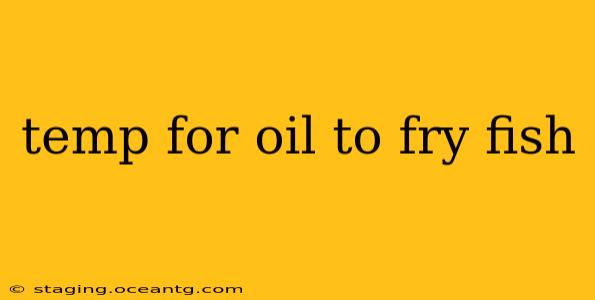Frying fish is a beloved culinary technique across the globe, resulting in crispy exteriors and tender, flaky interiors. But achieving that perfect golden-brown crust requires getting the oil temperature just right. Too low, and your fish will absorb excessive oil and remain soggy. Too high, and you'll risk burning the outside before the inside is cooked through. This guide will explore the ideal temperature for frying fish and answer common questions surrounding this crucial aspect of fish preparation.
What is the ideal temperature for frying fish?
The optimal temperature for frying fish is generally between 350°F (175°C) and 375°F (190°C). This temperature range ensures even cooking, resulting in a crispy exterior and moist interior. Using a thermometer to monitor the oil temperature is crucial for achieving consistent results. Don't rely on visual cues alone, as oil temperature can fluctuate significantly.
How do I know if my oil is hot enough?
There are several ways to check if your oil has reached the correct frying temperature:
- Thermometer: The most accurate method is using a deep-fry thermometer. Simply insert the thermometer into the oil (avoiding the bottom of the pan) and check the reading.
- Breadcrumb Test: Drop a small piece of breadcrumb into the oil. If it sizzles and browns within 15-20 seconds, the oil is ready.
- Wooden Spoon Test: Carefully insert a wooden spoon into the oil. If small bubbles consistently rise around the spoon, the oil is at the right temperature.
What happens if the oil is too hot or too cold?
Too Hot: If the oil is too hot, the fish will burn on the outside before the inside cooks through. You'll end up with a blackened exterior and a raw or undercooked center.
Too Cold: If the oil is too cold, the fish will absorb excessive oil, resulting in a soggy, greasy texture. The fish may also stick to the pan, making it difficult to flip or remove.
What type of oil is best for frying fish?
Various oils work well for frying fish, each with its own advantages and disadvantages:
- Vegetable Oil: A versatile and widely available option with a high smoke point.
- Canola Oil: Another popular choice with a high smoke point and neutral flavor.
- Peanut Oil: Offers a slightly nutty flavor and a high smoke point.
- Soybean Oil: A good all-purpose oil with a high smoke point.
Avoid using oils with low smoke points, such as olive oil or butter, as they can burn easily at high temperatures.
How much oil should I use when frying fish?
The amount of oil you need depends on the size and shape of your frying pan and the amount of fish you are frying. Generally, you should have enough oil to submerge the fish about halfway, ensuring it cooks evenly. Avoid overcrowding the pan, as this can lower the oil temperature and result in uneven cooking.
Can I reuse frying oil for fish?
While you can reuse frying oil, it's important to strain it through a fine-mesh sieve to remove any food particles. Repeated use can reduce the oil's smoke point and affect the flavor of your food. Discard the oil if it becomes dark, smells rancid, or has a noticeably thick consistency.
By following these guidelines and using a thermometer to monitor the oil temperature, you can ensure perfectly fried fish every time, achieving that desirable balance of crispy exterior and tender interior. Enjoy your delicious, golden-brown fish!
